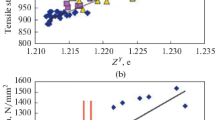On the basis of the results of statistical analysis of the in-service defects of high-strength railroad wheels and the data of related laboratory investigations of wheel steels, it is shown that the major part of these defects are pockmarks and flats formed on the rolling surface. Therefore, it is necessary to change the concept of selection of steels for high-strength wheels in order to take into account not only the characteristics of strength and hardness (wear resistance) but also the characteristics of crack resistance under the conditions of contact fatigue. The new concept should be based on the approaches of the structural mechanics of fatigue fracture and aimed at the production of high-strength wheel steels with lowered carbon contents and higher characteristics of cyclic crack-growth resistance under the conditions of mode I and mode II fracture.







Similar content being viewed by others
References
A. D. Lashko and O. M. Savchuk, “On the strategy of Ukrainian Railroads in the solution of the problem of removing the excess wear of the ‘wheel–rail’ couples,” Zaliznych. Transp. Ukr., No. 2–3, 2–4 (1997).
I. G. Uzlov, K. I. Uzlov, O. N. Perkov, and A. V. Knysh, “Scientific development and industrial implementation of the technology of microalloying and thermal hardening of highly wear resistant railroad all-rolled wheels,” in: Fundam. Prikl. Probl. Chern. Metallurg., Issue 7 (2004), pp. 231–243.
I. G. Kharchenko, “Operating reliability of the wheel pairs of freight cars,” Vagon. Park, No. 2, 21–22 (2008).
GOST 10791-2011. All-Rolled Wheels. Technical Specifications [in Russian], Standartinform, Moscow (2011).
S. Hang, P. Tao, L. Li, et al., “Frictional heat-introduced phase transformation on train wheel surface,” J. Iron Steel Res. Int., 15, No. 5, 49–56 (2008).
I. M. Andreiko and V. V. Kulyk, “Temperature dependence of mechanical characteristics of wheel steels,” Fiz.-Khim. Mekh. Mater., 47, No. 1, 113–115 (2011); English translation: Mater. Sci., 47, No. 1, 124–126 (2011).
O. P. Ostash, I. M. Andreiko, V. V. Kulyk, et al., “Contact-fatigue damage to the rolling surfaces of KP-2-type and KP-T-type railroad wheels,” in: Bull. Lazaryan Dnipropetrovs’k Nat. Univ. Railroad Transp. [in Ukrainian], Issue 39 (2011), pp. 118–122.
O. P. Datsyshyn, “Simulation of the initiation of contact fatigue defects and estimation of the durability of elements of tribological joints,” Fiz.-Khim. Mekh. Mater., 47, No. 2, 67–78 (2011); English translation: Mater. Sci., 47, No. 2, 188–200 (2011).
V. V. Panasyuk, O. P. Ostash, O. P. Datsyshyn, et al., “Service life of railroad wheels made of high-strength steel,” in: Problems of the Lifetime and Operating Safety of the Structures, Buildings, and Machines [in Ukrainian], E. Paton Institute of Electric Welding, Kyiv (2009), pp. 659–663.
O. P. Ostash, I. M. Andreiko, V. V. Kulyk, et al., “Low-temperature cyclic crack resistance of steels of railroad wheels,” Fiz.-Khim. Mekh. Mater., 44, No. 4, 52–57 (2008); English translation: Mater. Sci., 44, No. 4, 524–529 (2008).
O. P. Ostash, I. M. Andreiko, V. V. Kulyk, et al., “Influence of the mode of thermal treatment and load ratio on the cyclic crackgrowth resistance of wheel steels,” Fiz.-Khim. Mekh. Mater., 45, No. 2, 63–70 (2009); English translation: Mater. Sci., 45, No. 2, 211–219 (2009).
I. M. Andreiko, V. V. Kulyk, and O. P. Ostash, “Resistance of steels of railroad wheels to corrosion-fatigue fracture,” Fiz.-Khim. Mekh. Mater., 47, No. 5, 35–39 (2011); English translation: Mater. Sci., 47, No. 5, 608–612 (2011).
O. P. Ostash, I. M. Andreiko, V. V. Kulyk, and V. I. Vavrukh, “Influence of braking on the microstructure and mechanical behavior of steels of railroad wheel,” Fiz.-Khim. Mekh. Mater., 48, No. 5, 15–20 (2012).
A. I. Babachenko, A. A. Kononenko, Zh. A. Dement’eva, et al., “Investigation of the causes of formation of defects on the rolling surfaces of high-strength wheels in the process of operation,” Zaliznych. Transp. Ukr., No. 5, 35–38 (2010).
O. P. Ostash, A. I. Babachenko, I. M. Andreiko, et al., “Structural fracture mechanics and operating reliability of railroad wheels,” in: Fundamental and Applied Problems of Ferrous Metallurgy [in Russian], Issue 20 (2009), pp. 246–253.
Author information
Authors and Affiliations
Corresponding author
Additional information
Translated from Fizyko-Khimichna Mekhanika Materialiv, Vol. 48, No. 6, pp. 7–13, November–December, 2012.
Rights and permissions
About this article
Cite this article
Ostash, O.P., Anofriev, V.H., Andreiko, I.M. et al. On the concept of selection of steels for high-strength railroad wheels. Mater Sci 48, 697–703 (2013). https://doi.org/10.1007/s11003-013-9557-7
Received:
Published:
Issue Date:
DOI: https://doi.org/10.1007/s11003-013-9557-7




